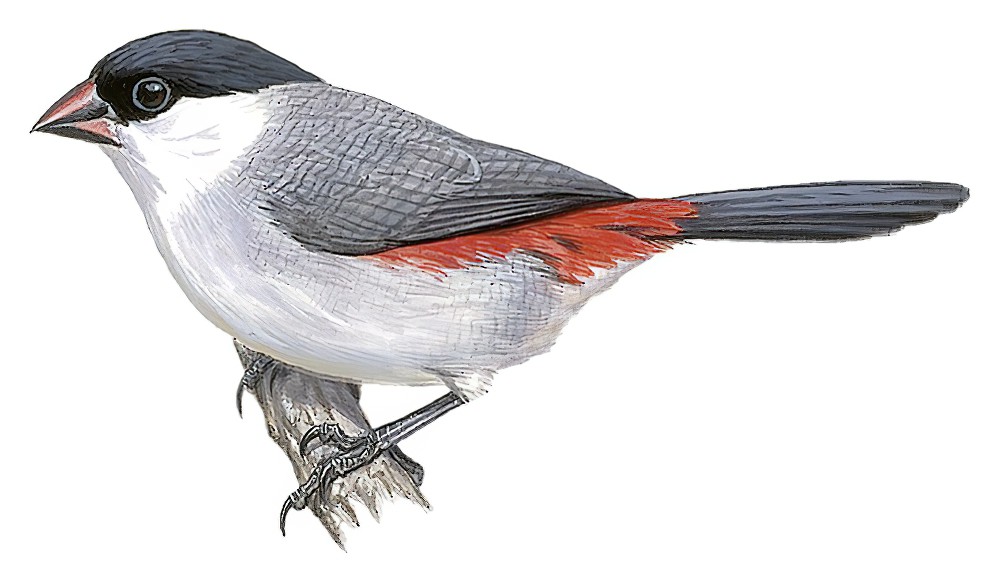Black-crowned Waxbill / Estrilda nonnula

Black-crowned Waxbill
SCI Name:
Protonym: Astrilda nonnula J.Orn. 31 p.425
Taxonomy: Passeriformes / Estrildidae / Estrilda
Taxonomy Code: blcwax2
Type Locality: Kudurma, eastern equatorial Africa [=Equatoria Province, Sudan] .
Author: Hartlaub
Publish Year: 1883
IUCN Status: Least Concern
DEFINITIONS
ESTRILDA
(Estrildidae; Ϯ Common Waxbill E. astrild) Specific name Loxia astrild Linnaeus, 1758. It has been suggested that the name derives from a German or Dutch avicultural term for a waxbill. However, an incandescent Reichenbach 1849, wrote that the name Estrelda, from astrild, was neither Latin nor English, nor anything else, and castigated the linguistically proficient authors who foisted it on the scientific community (“Der Name Estrelda, aus Astrild gemacht, ist weder lateinisch noch englisch, noch sonst etwas; man könnte ihn kaum deutsch-englisch nennen und muss erstauen, wie ein paar sprachkundige Männer ihn in die wissenschaft aufzunehmen vorsuchten”); "ESTRILDA. Rostrum breve, conicum, immarginatum. Alæ breves, rotundatæ; remige 1ma spuria, minuta, 3tia, 4ta, et 5ta æqualibus, longissimis. Cauda subelongata, gradata. ... Type. Loxia astrild. Linn. This, and the preceding genus [Amadina], appear strictly confined to the warm regions of the old world; and will detach a vast number of species from the Loxiæ and Fringillæ of Linnæus. I have endeavoured in vain to reconcile the different groups of these birds proposed by Brisson, Cuvier, and Vieillot, with any thing like a geographic or a natural arrangement; and this must be my apology for not adopting either their names or characters; the first would lead to much confusion, while the latter are artificial. The minute spurious quill, (which I have termed, for the sake of uniformity, the first), seems to be an unerring indication of an African or Asiatic origin; and I find the same character in all those I have seen from New Holland." (Swainson 1827); "Estrilda Swainson, Zool. Journ. iii, p. 349, 1827. Type by original designation, Loxia astrild Linn." (W. Sclater, 1930, Syst. Av. Aethiop., II, p. 794).
Var. Astrilda, Estrelda, Estrila.
Synon. Brunhilda, Glaucestrilda, Habropyga, Haplopyga, Krimhilda, Melpoda, Senegalus.
NONNULA
(Bucconidae; Ϯ Rusty-breasted Nunlet N. rubecula) Mod. L. nonnula nunlet, little nun < dim. Med. L. nonna nun < Late Gr. νοννα nonna nun < νοννος nonnos monk; "For the more debile and passerine form of Malacoptila, represented by the Bucco rubecula, Spix, and Lypornix ruficapilla, Tschudi, I propose the new generic or subgeneric appellation Nonnula, type N. rubecula (Bucco rubecula, Spix, Av. Bras. i. t. 39. fig. 1. p. 51). The members of this section are much inferior in size to the true Malacoptilæ." (P. Sclater 1853).
Synon. Microtrogon.
nonnula
Mod. L. nonnula nunlet, little nun < dim. Med. L. nonna nun < Late Gr. νοννα nonna nun < νοννος nonnos monk.
SUBSPECIES
Black-crowned Waxbill (nonnula)
SCI Name: Estrilda nonnula nonnula
NONNULA
(Bucconidae; Ϯ Rusty-breasted Nunlet N. rubecula) Mod. L. nonnula nunlet, little nun < dim. Med. L. nonna nun < Late Gr. νοννα nonna nun < νοννος nonnos monk; "For the more debile and passerine form of Malacoptila, represented by the Bucco rubecula, Spix, and Lypornix ruficapilla, Tschudi, I propose the new generic or subgeneric appellation Nonnula, type N. rubecula (Bucco rubecula, Spix, Av. Bras. i. t. 39. fig. 1. p. 51). The members of this section are much inferior in size to the true Malacoptilæ." (P. Sclater 1853).
Synon. Microtrogon.
Black-crowned Waxbill (elizae)
SCI Name: Estrilda nonnula elizae
elizae
● Female eponym; dedicatee not yet identified; "31. CRYPTOSPIZA ELIZÆ, n. sp. ♂. Similis C. oculari et C. reichenowi, sed pileo et collo postico sordide olivascenti-fuscis et subcaudalibus nigris distinguenda. ... Hab. Bakaki, 4000 feet" (Alexander 1903, Bull. Brit. Ornith. Cl., 13, 38), but probably after Lady Eliza Alexander, one of the author’s relatives (syn. Cryptospiza reichenovii).
● Female eponym; dedicatee not yet identified; "ESTRILDA ELIZÆ, n. sp. E. similis E. nonnulæ, sed gastræo griseo tincto, subcaudalibus plumbeis. ... Hab. Moka, Fernando Po" (Alexander 1903, Bull. Brit. Ornith. Cl., 13, 54), but probably after Lady Eliza Alexander, one of the author's relatives (subsp. Estrilda nonnula).
Black-crowned Waxbill (eisentrauti)
SCI Name: Estrilda nonnula eisentrauti
eisentrauti
Prof. Dr Martin Eisentraut (1902-1994) German zoologist, collector in West Africa (subsp. Estrilda nonnula, Melignomon (Peter Colston (pers. comm.) had intended to name the Yellow-footed Honeyguide ‘Melignomon serlei’ after Dr William Serle, the Scottish ornithologist who collected the first specimen, but generously sent a copy of his paper, “to Dr. M. Louette in October 1980, shortly after it had been submitted for publication. Dr. Louette has since seen fit to describe the new honeyguide without informing us of his intention ... His paper came to hand while this one was in proof and it has been possible to do little more than delete the proposed name and substitute eisentrauti for it in the text and table” (Colston 1981). “Before describing the taxon, M. Louette had offered to send [the holotype] to the British Museum (Natural History) in order to enlarge the existing material for comparison. However, this offer was declined, despite the intension [sic] of a possible co-authorship” (Louette et al. 2010)) (see serlei)).
UPPERCASE: current genus
Uppercase first letter: generic synonym
● and ● See: generic homonyms
lowercase: species and subspecies
●: early names, variants, mispellings
‡: extinct
†: type species
Gr.: ancient Greek
L.: Latin
<: derived from
syn: synonym of
/: separates historical and modern geographic names
ex: based on
TL: type locality
OD: original diagnosis (genus) or original description (species)












